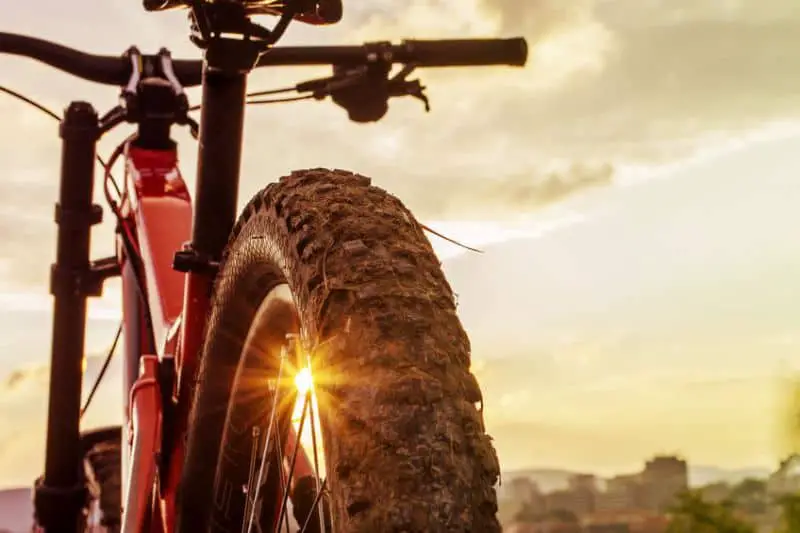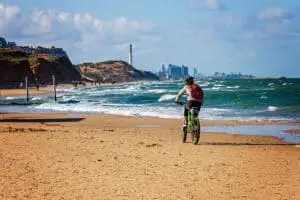Last Updated on August 2, 2022
Mountain bikes are all-terrain vehicles. You can ride them wherever and whenever.
And that includes the beach.
The thing is, riding bikes on the beach is different than riding in other places like on trails or the urban jungle.
The beach, specifically saltwater, is very corrosive to your bike and its components. It doesn’t even matter if you don’t get splashed up with water from the shore. Even the ocean breeze can corrode your expensive alloy and carbon parts because of its saltwater saturation levels.
Add in the threat of having sand insert on the nooks and crannies of your bike and you get yourself in one big trouble.
That’s if, of course, if you don’t clean your bike properly after you ride on the beach.
Here, we’re going to help you learn the proper way of cleaning your bike after a beach ride.
Things You Need
Water source
A clean water source is essential to rinse the bike off any dirt and soap afterward. You should use a hose and connect it to an outdoor faucet. Make sure that it doesn’t give off high-pressure water.
Workstand
This is what will keep your bike in place. Any bike stand will do, but a workstation just like the Park Tool work stand is your best choice.
Thick brush
Get a brush that has thick and moderately hard bristles. You are going to use this to brush the tires.
Soft-bristle mini brush
This brush should have soft bristles. You will use this on the entire bike body.
Soap
Any soap will do. But you should use a bike-specific cleaner to avoid over-drying.
Degreaser
A degreaser is needed to easily remove the sand, dirt, and grime from the bike. Simply spray this on the drivetrain. But make sure that you avoid spraying this on the suspension as it can seep into the linings and damage the oil reserves.
Chain lube
Use a chain lube after you finish cleaning the bike. You can either use a wet lube or a dry lube depending on the place you’ll be riding on.
Chamois towel
You will use this to dry the bike after washing it.
Microfiber cloth
This serves as the final dryer. It is effective in polishing your bike’s looks and getting rid of any smudges from the chamois towel.
Step-by-step Guide on Bike Cleaning After Beach Ride

Step 1: Rinse with water
The first thing you need to do is to rinse the bike with water. First, place your bike securely on the workstation. Then connect the hose to the faucet and open it to the maximum level. But make sure that the flow of water isn’t very strong.
Some people want to use a pressure washer when cleaning their bikes. That’s alright. But that can pose numerous dangers to your bike’s bearings as the strong water pressure can force water into the linings and bearings of mountain bikes.
This is not good if you have a full-suspension bike as it can rust the bolts and compromise the smoothness of its suspension. If possible, keep the water flow to moderate levels. And don’t direct the hose towards the hubs to prevent leakage. It is also best if you use warm water.
Start rinsing off the top of your bike, specifically the handlebars. Then slowly make your way down. You can hold the hose on your right hand and use your other hand to manually remove the sand and grime from the bike.
Step 2: Apply soap
Now that you have rinsed your bike, it is now time to apply soap. You can use a soap washer to easily distribute soap on your bike. You can use just pour liquid soap onto your hands and manually apply the soap throughout the bike.
Do this slowly so that you won’t scratch the frame or stanchions of the shocks if in case there is still some sand left on it. Work your way up and then downwards. Start on the grips, then towards the saddle, and then the fork.
Then slowly apply it across the bike’s frame and then on the drivetrain. You can also use a degreaser on the drivetrain if you have one. Just make sure this won’t reach the hubs.
Just leave the degreaser there for 10 to 15 minutes. You can also use a sponge when applying soap. But based on our experience, it’s still better to do this by hand so you get a good feel of your bike’s texture and status.
Step 3: Clean the suspension
Get the soft brush and slowly brush it on the lower end of the stanchions. Do this very slowly and gently so you won’t scratch the sensitive stanchions. Then work your way across the lowers of the fork. Head over to the dropper post stanchions, and then on your rear shock.
Step 4: Brush the body
Get the soft-bristle brush again and use it to scrape off any sand that might have stuck on the frame. Start on the head tube then towards the top tube and then down tube.
The down tube is where most of the dirt and mud sticks to so spend more time on that. Also, work on the chainstay as mud can easily splash on it.
Step 5: Brush the tires
Get the large brush with hard bristles and scrape off any dirt that’s on the tires. You can easily do this by just turning the wheels with one hand and using your other hand to scrape off the dirt on the tires.
You don’t need to move your right hand which holds the brush. Just put it in place as you turn the wheels using your other hand.
Step 6: Wash the brakes
Direct the hose’s running water onto the brake calipers and brake pads. This gets rid of the sand and dirt that can lower your braking power. Also, get a sponge and wipe off any dirt on the disc brake rotors. Then rinse them off with water.
Step 6: Deep clean the drivetrain
Now it’s time to deep clean your drivetrain. Get your soft bristle brush and brush the cogs hard. You don’t have to worry about doing it hard because this won’t damage the cassette. Also, use a chain cleaning device for your bike chain if you want to make the process easier.
Apply soap on it. Then spray degreaser and leave it for 10 to 15 minutes. Apply soap again and then rinse with water.
Step 7: Rinse with water
Get the hose and rinse your entire bike with water. Make sure that there is no more soap residue left.
Step 8: Wipe dry with a chamois towel
Use a chamois towel to dry the mountain bike. See to it that all the corners are wiped clean and dry. You’ll then notice that there are smudges. That’s where a microfiber cloth comes in.
Step 9: Wipe dry with a microfiber cloth
Use your microfiber cloth to polish the dry bike. The goal here is to get rid of smudges and make the bike look sparkling clean.
Step 10: Apply silicone spray
Apply silicone spray to the bike. Simply spray some onto another piece of clean microfiber cloth. And then wipe the cloth directly on the fork stanchions, dropper stanchion, and rear shock stanchion. This gets rid of any residue and makes sure that dust and dirt won’t stick
Step 11: Apply lube
Apply chain lubricant on your chain to make shifting smoother and more reliable. And there you have it, a clean bike.
Conclusion
Cleaning your mountain bike after using it on the beach is important. Not only does this avoid corrosion and rust, but it also makes sure that there is no sand, dust, or other debris lodged on your bike’s components.
Riding on the beach is nice. But it has a lot of dangers when it comes to bike maintenance. So be sure to clean your bike immediately after using it on the beach to have a better and more enjoyable next ride.

